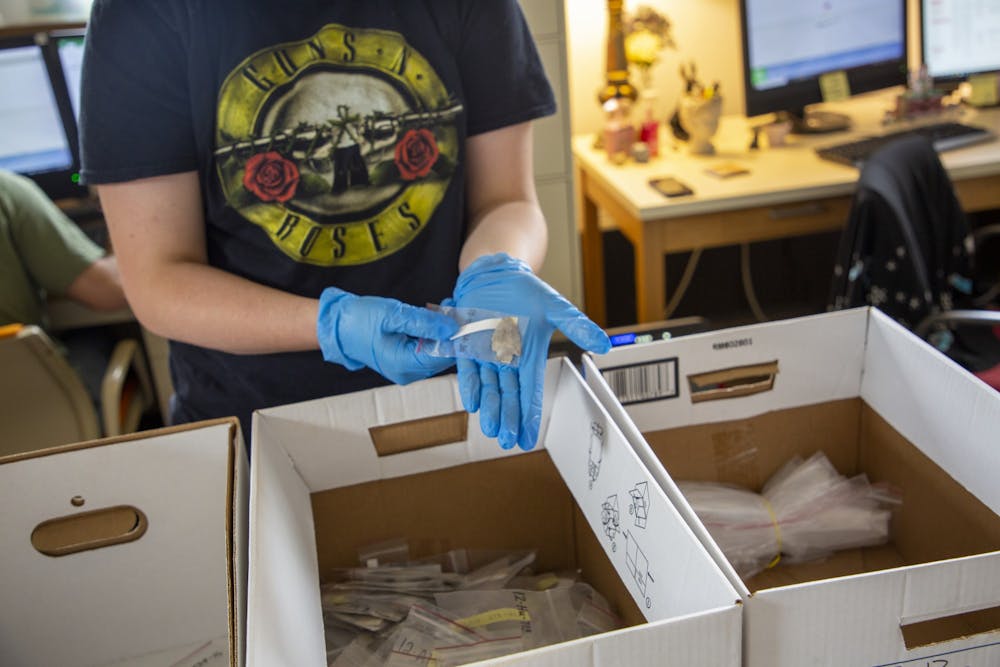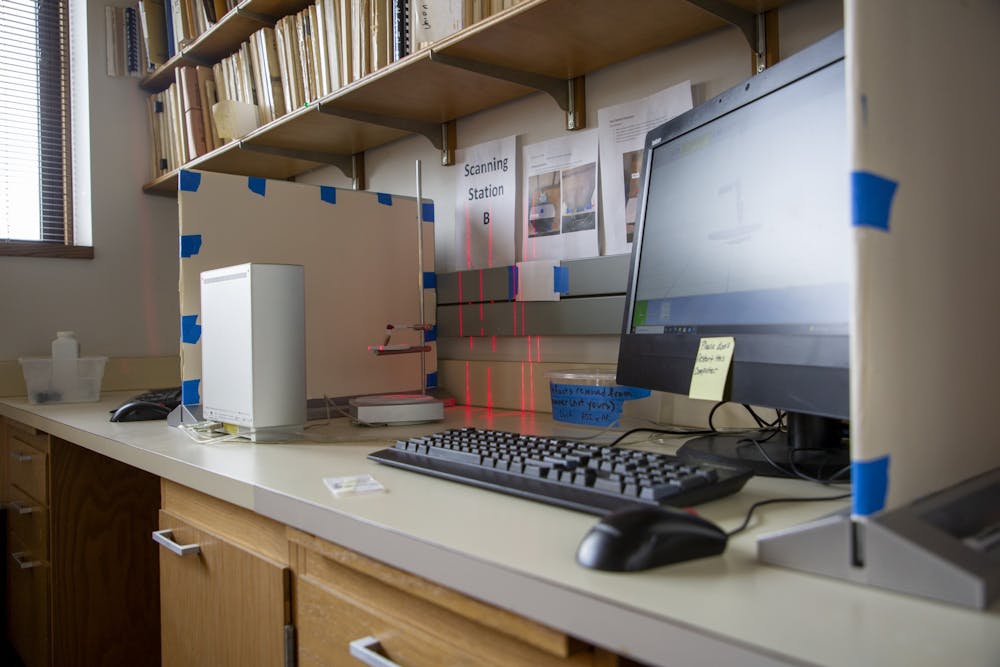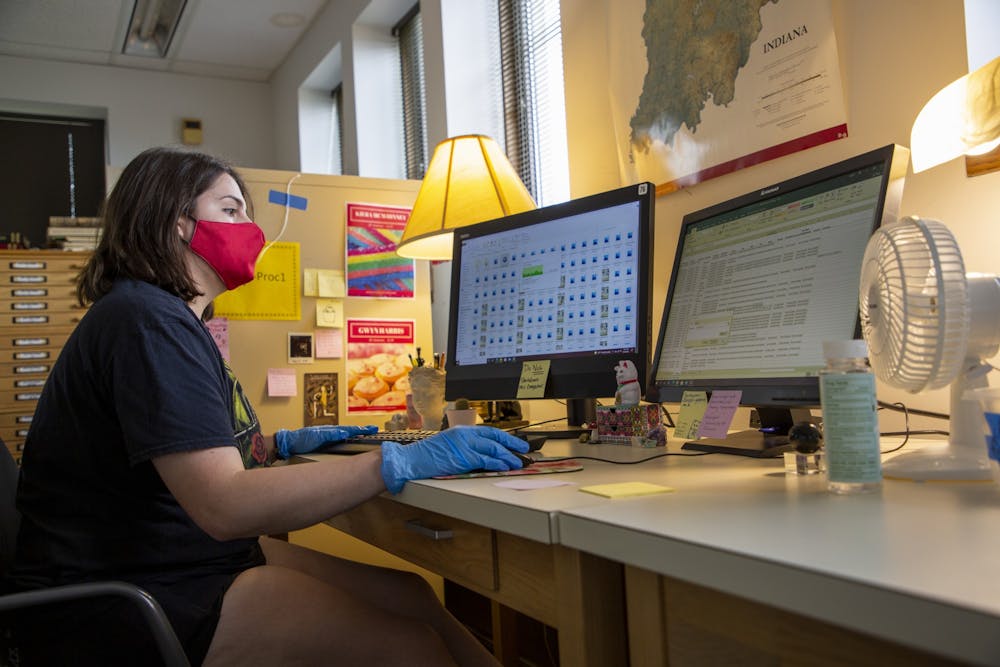Funding for the Applied Anthropology Laboratories digitization project
Ball State’s Applied Anthropology Laboratories’ (AAL) digitization project is supported by a $257,478 Digitizing Hidden Collections grant from the Council on Library and Information Resources. The grant program is funded by the Andrew W. Mellon Foundation.
Most AAL projects are externally funded by a variety of sources. The funding helps pay for student labor costs, equipment and travel expenses, as well as other research necessities.
Sources: Applied Anthropology Laboratories Virtual Open House and Caroline Heston, education and outreach coordinator for AAL
Get involved with Applied Anthropology Laboratories
Most students involved in Applied Anthropology Laboratories (AAL) fieldwork are studying anthropology, preservation, history or a related subject; however, any student, regardless of what they study, can apply for AAL jobs.
Students interested in AAL should have some foundational knowledge of anthropology, and AAL asks that students complete at least one anthropology course before starting fieldwork. AAL will provide training on artifacts and fieldwork for new students joining the crew.
Visit the AAL in Burkhardt Building room 314, or call 765-285-5328. Operating hours are 8 a.m.–5 p.m. Monday–Friday.
Source: Caroline Heston, education and outreach coordinator for AAL
For senior anthropology major Kiera McWhinney, figuring out what profession she wanted to work in took almost four years of college, a new job within her minor and finding the right mix of anthropology and design.
McWhinney entered Ball State as a graphic design major, but she didn’t realize until the COVID-19 pandemic began that she didn’t want to spend so much of her time on a computer.
“We moved to online [classes], and I started doing a lot of projects exclusively on a computer,” McWhinney said. “When you’re at school, it doesn’t feel like that because you’re in class all the time and you’re talking with people.”
McWhinney hadn’t considered further study of anthropology before, but, after applying for a job as a crew member in the Applied Anthropology Laboratories (AAL), she realized she wanted to spend time outdoors helping with archeological digs and compiling research for different projects.
“I also make 3D models of things in the lab sometimes, so that incorporates the design that I like,” she said. “That’s when I decided, ‘I’m switching to anthropology.’ I did the lab fieldwork training and knew I wanted to do this.”
McWhinney and other AAL staff and students are currently working on a digitization project of more than 4,000 artifacts including research papers, images and 3D digital scans.
Christine Thompson, co-principle investigator on the digitization project and AAL assistant director, said staff have completed 3D scans of about 2,000 artifacts so far and uploaded more than 700 scans to the 3D viewing site Sketchfab. Thompson said she appreciates the project is digitizing more than just the “eye-catching” artifacts.
“I think it’s really interesting that we’re scanning the things that maybe are a little less exciting, but they tell a story when you look at them in aggregate — you know where and when they were found, and you can compare the differences,” Thompson said. “That’s a story that we don’t always tell because we don’t always have them all together.”

Senior anthropology major Kiera McWhinney displays artifacts in the Applied Anthropology Lab (AAL) that have been uploaded to the lab’s Sketfab website, Aug. 30. The AAL digitization project will make more than 4,000 artifacts accessible to the public once the project is completed. Grace McCormick, DN
Thompson said digitizing artifacts this past year has required physical reorganization of the lab, as students and other people involved in the project sometimes need to rename older artifacts or match materials to their proper years of discovery.
“For a while, I had two big racks in my office and would pull out groups of things for other people to work with,” she said. “We’ve had to be very nimble [and] flexible in how we use our space, our time and our resources.”
AAL started the digitization project in summer 2020 with the goal of digitizing all of their reports of investigation to make their archives accessible for archeologists all over the world, said Caroline Heston, education and outreach coordinator for AAL. She said most of AAL’s work is concentrated in Indiana and surrounding states.
“It’s very hard work — physically digging holes into the ground and hiking through literal wilderness and crawling through thorns — it’s difficult hard work, but it’s also really fun, and there’s just so much camaraderie when you have that crew that you’ve been with for weeks,” Heston said. “Even when it gets really difficult, you have each other.”
Kevin Nolan, co-principle investigator on the digitization project and AAL director, said digitization is different from most of AAL’s fieldwork because those involved aren’t making new discoveries, but they are making existing research more accessible.
“On most of the projects, we’re exploring something new or making discoveries to get a more accurate picture of something,” he said. “Here, we’re just compiling and making accessible all of this other research. There’s no one theme or concept that’s going to really come out of this, other than open access to the raw data and making all of these efforts that have gone on here sustainable.”
The digitization project will last through next year, Nolan said, and he hopes it will come close to digitizing all projects AAL has completed since the 1960s.
“We wanted to build archival digital records that are going to be preserved regardless of what happens to the lab, our computers and physical storage, but we also want to make it more accessible and more useful,” Nolan said. “This is going to be thousands of objects that anybody anywhere can study and do what they want with. That’s a pretty much unparalleled public archeological resource, as far as I know.”
Nolan also said he hopes the digital archives can be used not just by researchers and scholars, but in classrooms, too.
“Most of the time, you limit the amount of real and valuable artifacts that you pass around to 30 undergraduates because a broken artifact is broken forever,” he said. “With this, we can print off multiple copies of the same thing using a 3D printer.”

Scanning stations complete 3D scans of artifacts in the Applied Anthropology Lab, Aug. 30. Once staff are done editing 3D scans, they are uploaded online with information on where the artifact was found, which aims to offer people more information on their local anthropology. Grace McCormick, DN
AAL currently has three 3D scanning devices for artifacts, and Thompson said they are receiving three more soon. She said once student workers understand the scanners, they can move through artifacts efficiently, though there are sometimes problems to solve.
“This project is so dependent on having good student lab assistants and graduate students,” Thompson said. “We have a really good team here, and I really appreciate the effort that students on this team put forth, because some of these tasks really take some thought, and you have to pay attention.”
Now that McWhinney has assisted with seven different AAL projects, she said she is grateful for the professional experience she’s received.
“There’s not a lot of schools around here that offer experience in this field before you’re graduated,” she said. “That’s something really special that Ball State does. Especially with COVID, I didn’t think I’d be able to make friends in my department at all, but, with fieldwork, I was actually able to make friends because I worked here, which is something I wouldn’t have been able to do otherwise, and that’s invaluable.”
Contact Grace McCormick with comments at grmccormick@bsu.edu or on Twitter @graceMc564.





